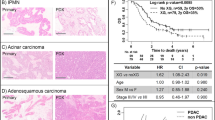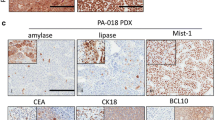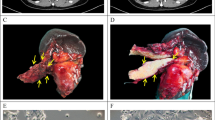Abstract
Ampulla of Vater cancers (AVC) are of clinical relevance, as they represent more than one-third of patients undergoing surgery for pancreaticoduodenal malignancies and have a better prognosis than periampullary cancers of pancreaticobiliary origin. The availability of cellular models is crucial to perform cell biology and pharmacological studies and clarify the relationship between AVC and pancreatic and biliary cancers. Numerous cell lines are available for pancreatic and biliary adenocarcinomas, while only two have been reported recently for AVC. These were derived from a poor and a well-differentiated AVC, and both had wild-type K-ras and mutated p53. We report the establishment of a novel AVC cell line (AVC1) derived from a moderately differentiated cancer, having a mutated K-ras, wild-type p53, and methylated p16. Thus, our cell line adds to the spectrum of available in vitro models representative of the different morphological and molecular presentations of primary AVC. We further characterized AVC1 for the expression of relevant cell surface molecules and sensitivity to chemotherapeutic agents of common clinical use. It expresses MHC-I and CD95/Fas, while HLA-DR, CD40, CD80, CD86, MUC-1, MUC-2, and ICAM-1/CD54 are absent. It has a low to moderate sensitivity to both 5-FU and gemcitabine, at variance with much higher sensitivity displayed by two pancreatic ductal carcinoma cell lines. Lastly, AVC1 can be readily xenografted in immunodeficient mice, making it a suitable model for pre-clinical studies.



Similar content being viewed by others
References
Accolla RS, Gross N, Carrel S, Corte G (1981) Distinct forms of both alpha and beta subunits are present in the human Ia molecular pool. Proc Natl Acad Sci U S A 78:4549–4551
Achille A, Biasi MO, Zamboni G, Bogina G, Iacono C, Talamini G, Capella G, Scarpa A (1997) Cancers of the papilla of Vater: mutator phenotype is associated with good prognosis. Clin Cancer Res 3:1841–1847
Achille A, Baron A, Zamboni G, Di Pace C, Orlandini S, Scarpa A (1998) Chromosome 5 allelic losses are early events in tumours of the papilla of Vater and occur at sites similar to those of gastric cancer. Br J Cancer 78:1653–1660
Agrawal B, Krantz MJ, Reddish MA, Longenecker BM (1998) Cancer-associated MUC1 mucin inhibits human T-cell proliferation, which is reversible by IL-2. Nat Med 4:43–49
Allema JH, Reinders ME, van Gulik TM, van Leeuwen DJ, Verbeek PC, de Wit LT, Gouma DJ (1995) Results of pancreaticoduodenectomy for ampullary carcinoma and analysis of prognostic factors for survival. Surgery 117:247–253
Danen EH, Yamada KM (2001) Fibronectin, integrins, and growth control. J Cell Physiol 189:1–13
Garrido F, Cabrera T, Concha A, Glew S, Ruiz-Cabello F, Stern PL (1993) Natural history of HLA expression during tumour development. Immunol Today 14:491–499
Hahn SA, Bartsch D, Schroers A, Galehdari H, Becker M, Ramaswamy A, Schwarte-Waldhoff I, Maschek H, Schmiegel W (1998) Mutations of the DPC4/Smad4 gene in biliary tract carcinoma. Cancer Res 58:1124–1126
Hanski C, Hofmeier M, Schmitt-Graff A, Riede E, Hanski ML, Borchard F, Sieber E, Niedobitek F, Foss HD, Stein H, Riecken EO (1997) Overexpression or ectopic expression of MUC2 is the common property of mucinous carcinomas of the colon, pancreas, breast, and ovary. J Pathol 182:385–391
Herman JG, Graff JR, Myohanen S, Nelkin BD, Baylin SB (1996) Methylation-specific PCR: a novel PCR assay for methylation status of CpG islands. Proc Natl Acad Sci U S A 93:9821–9826
Hoffman JP, Cooper HS, Young NA, Pendurthi TK (1998) Preoperative chemotherapy of chemoradiotherapy for the treatment of adenocarcinoma of the pancreas and ampulla of Vater. J Hepatobiliary Pancreat Surg 5:251–254
Howe JR, Klimstra DS, Cordon-Cardo C, Paty PB, Park PY, Brennan MF (1997) K-ras mutation in adenomas and carcinomas of the ampulla of vater. Clin Cancer Res 3:129–133
Klempnauer J, Ridder GJ, Pichlmayr R (1995) Prognostic factors after resection of ampullary carcinoma: multivariate survival analysis in comparison with ductal cancer of the pancreatic head. Br J Surg 82:1686–1691
Ku JL, Yoon KA, Kim IJ, Kim WH, Jang JY, Suh KS, Kim SW, Park YH, Hwang JH, Yoon YB, Park JG (2002) Establishment and characterisation of six human biliary tract cancer cell lines. Br J Cancer 87:187–193
Lee JH, Whittington R, Williams NN, Berry MF, Vaughn DJ, Haller DG, Rosato EF (2000) Outcome of pancreaticoduodenectomy and impact of adjuvant therapy for ampullary carcinomas. Int J Radiat Oncol Biol Phys 47:945–953
Lemonnier FA, Rebai N, Le Bouteiller PP, Malissen B, Caillol DH, Kourilsky FM (1982) Epitopic analysis of detergent-solubilized HLA molecules by solid-phase radioimmunoassay. J Immunol Methods 54:9–22
Luttges J, Zamboni G, Longnecker D, Kloppel G (2001) The immunohistochemical mucin expression pattern distinguishes different types of intraductal papillary mucinous neoplasms of the pancreas and determines their relationship to mucinous noncystic carcinoma and ductal adenocarcinoma. Am J Surg Pathol 25:942–948
Luttges J, Feyerabend B, Buchelt T, Pacena M, Kloppel G (2002) The mucin profile of noninvasive and invasive mucinous cystic neoplasms of the pancreas. Am J Surg Pathol 26:466–471
Mehta VK, Fisher GA, Ford JM, Poen JC, Vierra MA, Oberhelman HA, Bastidas AJ (2001) Adjuvant chemoradiotherapy for “unfavorable” carcinoma of the ampulla of Vater: preliminary report. Arch Surg 136:65–69
Mehta VK, Poen JC, Ford JM, Oberhelman HA, Vierra MA, Bastidas AJ, Fisher GA (2001) Protracted venous infusion 5-fluorouracil with concomitant radiotherapy compared with bolus 5-fluorouracil for unresectable pancreatic cancer. Am J Clin Oncol 24:155–159
Moore P, Sipos B, Orlandini S, Sorio C, Real F, Lemoine N, Gress T, Bassi C, Klöppel G, Kalthoff H, Löhr M, Scarpa A (2001) Genetic profile of 22 pancreatic carcinoma cell lines: analysis of K-ras, p53, p16 and DPC4/Smad4. Virchows Arch 439:798–802
Moore PS, Orlandini S, Zamboni G, Capelli P, Rigaud G, Falconi M, Bassi C, Lemoine NR, Scarpa A (2001) Pancreatic tumours: molecular pathways implicated in ductal cancer are involved in ampullary but not in exocrine nonductal or endocrine tumorigenesis. Br J Cancer 84:253–262
Percy C, van Holten V, Muir C (eds) (1990) International classification of diseases for oncology (ICD-O), 2nd edn. World Health Organization, Geneva
Roberts MS, Woods AJ, Shaw PE, Norman JC (2002) ERK1 associates with alpha vbeta 3 integrin and regulates cell spreading on vitronectin. J Biol Chem 278:1975–1985
Roder JD, Schneider PM, Stein HJ, Siewert JR (1995) Number of lymph node metastases is significantly associated with survival in patients with radically resected carcinoma of the ampulla of Vater. Br J Surg 82:1693–1696
Scarpa A, Capelli P, Zamboni G, Oda T, Mukai K, Bonetti F, Martignoni G, Iacono C, Serio G, Hirohashi S (1993) Neoplasia of the ampulla of Vater. Ki-ras and p53 mutations. Am J Pathol 142:1163–1172
Scarpa A, Zamboni G, Achille A, Capelli P, Bogina G, Iacono C, Serio G, Accolla RS (1994) ras-family gene mutations in neoplasia of the ampulla of Vater. Int J Cancer 59:39–42
Scarpa A, Di Pace C, Talamini G, Falconi M, Lemoine NR, Iacono C, Achille A, Baron A, Zamboni G (2000) Cancer of the ampulla of Vater: chromosome 17p allelic loss is associated with poor prognosis. Gut 46:842–848
Schwartz MA, Baron V (1999) Interactions between mitogenic stimuli, or, a thousand and one connections. Curr Opin Cell Biol 11:197–202
Scupoli MT, Sartoris S, Tosi G, Ennas MG, Nicolis M, Cestari T, Zamboni G, Martignoni G, Lemoine NR, Scarpa A, Accolla RS (1996) Expression of MHC class I and class II antigens in pancreatic adenocarcinomas. Tissue Antigens 48:301–311
Shirai Y, Tsukada K, Ohtani T, Koyama S, Muto T, Watanabe H, Hatakeyama K (1995) Carcinoma of the ampulla of Vater: histopathologic analysis of tumor spread in Whipple pancreatoduodenectomy specimens. World J Surg 19:102–106
Sipos B, Moser S, Kalthoff H, Torok V, Lohr M, Kloppel G (2003) A comprehensive characterization of pancreatic ductal carcinoma cell lines: towards the establishment of an in vitro research platform. Virchows Arch 442:444–452
Sorio C, Bonora A, Orlandini S, Moore PS, Capelli P, Cristofori P, Dal Negro G, Marchiori P, Gaviraghi G, Falconi M, Pederzoli P, Zamboni G, Scarpa A (2001) Successful xenografting of cryopreserved primary pancreatic cancers. Virchows Arch 438:154–158
Talamini MA, Moesinger RC, Pitt HA, Sohn TA, Hruban RH, Lillemoe KD, Yeo CJ, Cameron JL (1997) Adenocarcinoma of the ampulla of Vater. A 28-year experience. Ann Surg 225:590–599
Terada T, Ohta T, Sasaki M, Nakanuma Y, Kim YS (1996) Expression of MUC apomucins in normal pancreas and pancreatic tumours. J Pathol 180:160–165
Yonezawa S, Taira M, Osako M, Kubo M, Tanaka S, Sakoda K, Takao S, Aiko T, Yamamoto M, Irimura T, Kim YS, Sato E (1998) MUC-1 mucin expression in invasive areas of intraductal papillary mucinous tumors of the pancreas. Pathol Int 48:319–322
Zhang SY, Klein-Szanto AJ, Sauter ER, Shafarenko M, Mitsunaga S, Nobori T, Carson DA, Ridge JA, Goodrow TL (1994) Higher frequency of alterations in the p16/CDKN2 gene in squamous cell carcinoma cell lines than in primary tumors of the head and neck. Cancer Res 54:5050–5053
Acknowledgements
This study was supported by grants from the Associazione Italiana Ricerca Cancro (AIRC) to A.S., Milan, Italy; Fondazione Cassa di Risparmio di Verona (Bando 2001); Ministero Università e Ricerca (Cofin 2002068231–2001068593), and Ministero Salute, Rome, Italy; European Community Grant QLG1-CT-2002–01196.
Author information
Authors and Affiliations
Corresponding author
Rights and permissions
About this article
Cite this article
Sorio, C., Moore, P.S., Ennas, M.G. et al. A novel cell line and xenograft model of ampulla of Vater adenocarcinoma. Virchows Arch 444, 269–277 (2004). https://doi.org/10.1007/s00428-003-0936-6
Received:
Accepted:
Published:
Issue Date:
DOI: https://doi.org/10.1007/s00428-003-0936-6




